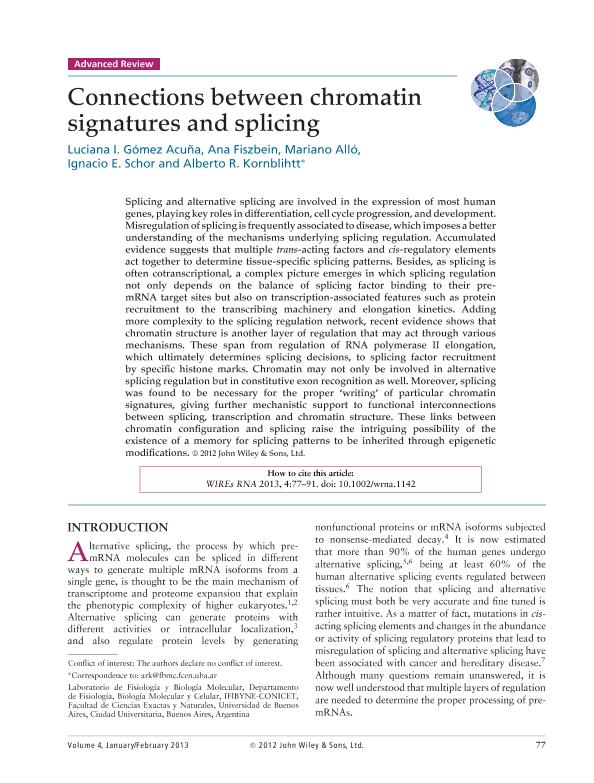Artículo
Connections between chromatin signatures and splicing
Gómez Acuña, Luciana Inés ; Fiszbein, Ana
; Fiszbein, Ana ; Alló, Mariano
; Alló, Mariano ; Schor, Ignacio Esteban
; Schor, Ignacio Esteban ; Kornblihtt, Alberto Rodolfo
; Kornblihtt, Alberto Rodolfo
 ; Fiszbein, Ana
; Fiszbein, Ana ; Alló, Mariano
; Alló, Mariano ; Schor, Ignacio Esteban
; Schor, Ignacio Esteban ; Kornblihtt, Alberto Rodolfo
; Kornblihtt, Alberto Rodolfo
Fecha de publicación:
02/2013
Editorial:
Wiley
Revista:
Wiley Interdisciplinary Reviews: RNA
ISSN:
1757-7012
Idioma:
Inglés
Tipo de recurso:
Artículo publicado
Clasificación temática:
Resumen
Splicing and alternative splicing are involved in the expression of most human genes, playing key roles in differentiation, cell cycle progression, and development. Misregulation of splicing is frequently associated to disease, which imposes a better understanding of the mechanisms underlying splicing regulation. Accumulated evidence suggests that multiple trans-acting factors and cis-regulatory elements act together to determine tissue-specific splicing patterns. Besides, as splicing is often cotranscriptional, a complex picture emerges in which splicing regulation not only depends on the balance of splicing factor binding to their pre-mRNA target sites but also on transcription-associated features such as protein recruitment to the transcribing machinery and elongation kinetics. Adding more complexity to the splicing regulation network, recent evidence shows that chromatin structure is another layer of regulation that may act through various mechanisms. These span from regulation of RNA polymerase II elongation, which ultimately determines splicing decisions, to splicing factor recruitment by specific histone marks. Chromatin may not only be involved in alternative splicing regulation but in constitutive exon recognition as well. Moreover, splicing was found to be necessary for the proper ‘writing’ of particular chromatin signatures, giving further mechanistic support to functional interconnections between splicing, transcription and chromatin structure. These links between chromatin configuration and splicing raise the intriguing possibility of the existence of a memory for splicing patterns to be inherited through epigenetic modifications.
Palabras clave:
Alternative Splicing
,
Epigenetics
Archivos asociados
Licencia
Identificadores
Colecciones
Articulos(IFIBYNE)
Articulos de INST.DE FISIOL., BIOL.MOLECULAR Y NEUROCIENCIAS
Articulos de INST.DE FISIOL., BIOL.MOLECULAR Y NEUROCIENCIAS
Citación
Gómez Acuña, Luciana Inés; Fiszbein, Ana; Alló, Mariano; Schor, Ignacio Esteban; Kornblihtt, Alberto Rodolfo; Connections between chromatin signatures and splicing; Wiley; Wiley Interdisciplinary Reviews: RNA; 4; 1; 2-2013; 77-91
Compartir
Altmétricas



